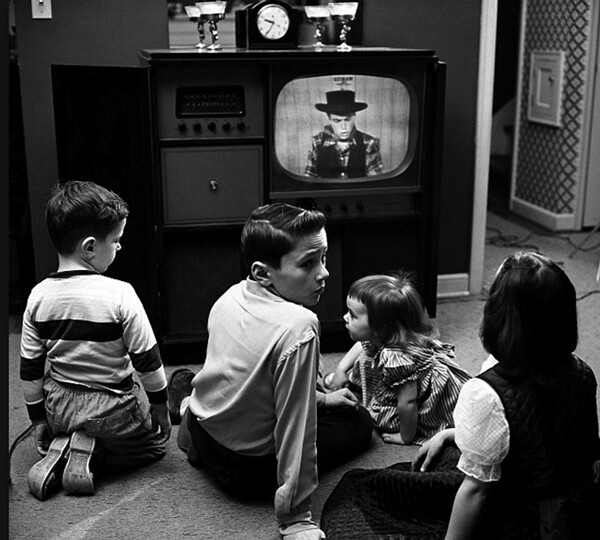Educational TV

One of my father’s happiest, proudest prejudices was about television. If it wasn’t educational it was junk and a waste of time. I might have been partial cause for spending too much time at the cartoon circuit. “Go outside, play, hit a ball” was daily instruction that I suspect drove father to a form of practicing what he preached. Commercial TV was father’s official enemy, except of course for nightly weather, sports, and Lawrence Welk. He was also OK with Ed Sullivan, programing I never understood seeing in the Honeymooners (the other Sunday night biggie) more humanity and ethos.
Keep in mind the cockiness of teenage boys when I say that to be honest I took considerable pleasure needling my father’s viewing choices. I found educational TV much too limited. It was fine if you wanted operatic singing or British accents which many of you will remember once summed up noncommercial programing. Was Basil Fawlty superior and more educational than Archie Bunker? I took teenage delight asking dad “Who’s singing tonight?” or snidely saying, “MM, that’s a nice accent.” Dad did not appreciate criticism of higher things, but as a young Ranger I knew the other side of fancy sounding talk. On the Range we were OK with a lingo lingering to today. We’d say “Let’s go store” and think nothing of the left out “to the.” Why say it if it wasn’t necessary? However, if we found ourselves among non-Rangers for school events the first sign of “what fur” instead of “what for” brought superior sniggers from those better and not dusted red with mined ore. Duluth kids, I have to say, were a pain that way. I’ll say (I believe on good grounds) many young Rangers didn’t saw Duluthians as snooty. There it is, live with it.
Regional and national variations are interesting. In some places it’s customary to greet a salesperson or cashier immediately on entering a store. If we recognize such a person at all it’s often not until checkout when we’re obliged to pay and sign or “swipe” something with a magical wizard device. If the sale (or purchase) is the main thing then the frills of civility and interaction can be more easily set aside as unnecessary. How often in some settings is a body to stack shelves more important than one that can give useful information? In some places self-service has gone from a touted customer convenience to an implied warning that the customer is on their own. You better know what you want beforehand because the amount of help you’ll get can be awfully skimpy.
I miss the teasing give and take shared with my father over things we learned from the TV. One of our favorites was (and I think the claim is still in use) a regional company saying their product was warm because it was flexible. Flexibility doesn’t necessarily mean warmth. Aluminum foil is flexible but not what I’d call wearable warmth. If it’s -20 are you going to push snow around with flexible sandwich bags on your hands to keep off the bite? I bet not, but we go along with the assumption for lots of reasons. We like local and natural products that fit an imagined life putting on warm flexible footwear before slipping into our kayaks (enclosed, heated cars) to go hunting in a grocery store for the walrus (prepacked meat) we’ll harpoon with a credit or debit card like real natives.
Quite recently I learned a lot from a Ford commercial for the Escape brand. Mother and daughter take off to hand chop and harvest their own tree. The commercial calls this a lesson presumably vital and needing to be taught. (The tree and chopping down are fanciful, indeed, but that’s to be expected in a warmth giving promo.) But what’s beyond the mother daughter pitch? What is the rest of the lesson? Is it owning a piece of land where your perfect tree can grow to the right size or is it thinking the perfect tree is “free range” and can be felled as you wish? It’s an Escape from reality gloss over who owns the tree, because if the mother didn’t Escape to her own property she went on the property of others to commit a theft of property. (Yes, she could have a permit, but that part of the lesson has been left out.) The thing, I think, is that we people can be relied on to see the better image and not ask too many questions. In the old days this was referred to as selling the sizzle instead of marketing a steak. That approach continues to work quite well.
But is a message more valid because we like it or it comes in a nicer wrapper; say a posh accent suggesting class and education and was just incidentally was a part of a great deal of major colonization? How much is sizzle and how much is meat? If giving sizzle (as in offering opinion) is reporting then this article might qualify as news reportage. What’s sizzle and what’s steak? Trying to figure that out is the real education.
Some of you might recall not too many years back the major protests in Seattle that shut down a World Trade Organization meeting. The WTO was criticized for destroying nations and abusing workers by encouraging (among other things) the movement of cheap labor. With the application of different seasonings and sizzle the same meat can be cooked as racist discrimination against migrants. The big business world trade interests should be thrilled by that change. Who needs to meet and plan if the sizzle can be swayed? If you’re a global business you don’t want to be held responsible for your laborers, and the more of them to play with the freer you can be. It is not easy to trace how the same body politic went from challenging migration to welcoming it and thereby embracing a goal of the WTO it so recently opposed. It’s about the sizzle, isn’t it? Burger is just burger, it’s sizzle sells the news.
